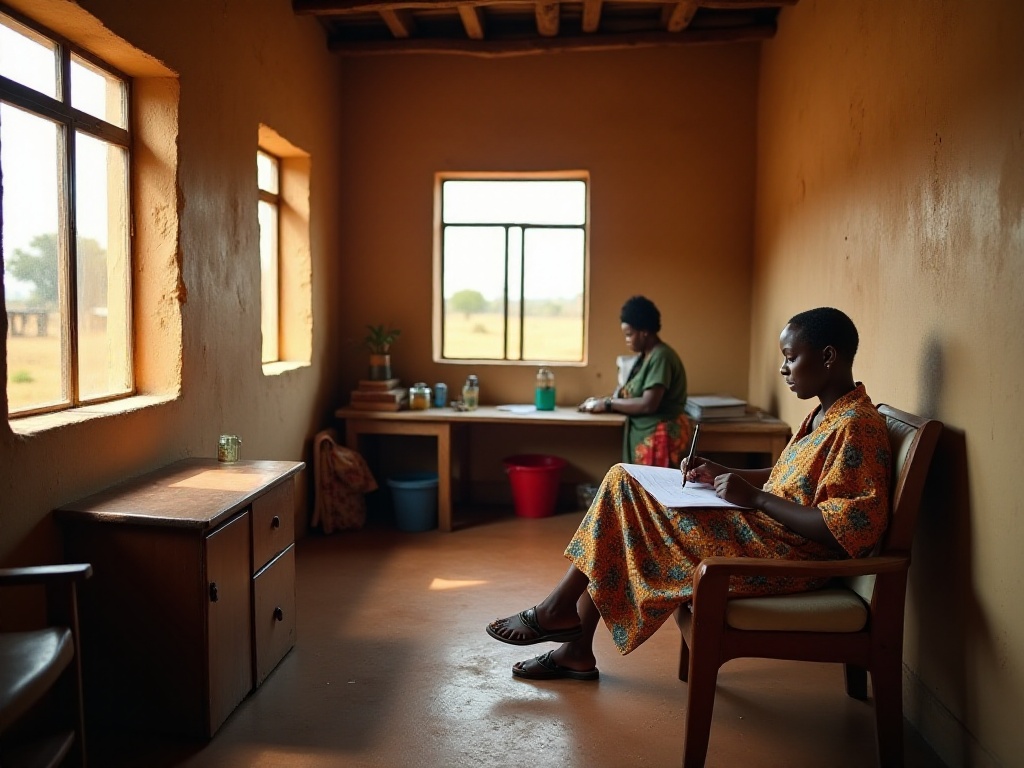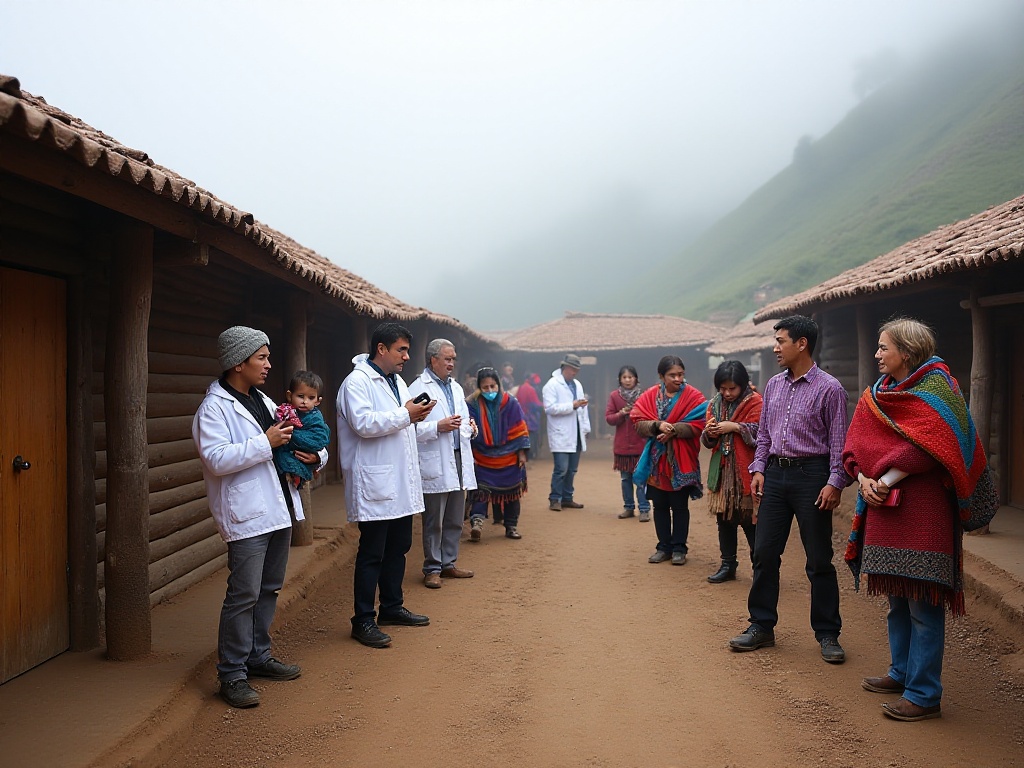One day in early 2024, while mindlessly scrolling through my phone, a photo caught my eye - the majestic Himalayan mountains emerging in the morning light, with children in colorful school uniforms at its foot. This was a promotional photo for IVHQ's (International Volunteer HQ) Nepal education program. At that moment, I thought how romantic it would be to teach under the watchful eye of the world's highest peaks!
I acted immediately! I opened my laptop and started researching IVHQ. Founded in 2007, it's an international volunteer organization with projects in over 40 countries. I chose a two-month education program in Nepal, paid the program fee, and began intense preparations.
My friends said I was crazy to leave my comfortable life behind to "suffer" in such a far-off place. But in my view, isn't youth the time to chase dreams with passion? Besides, teaching at the foot of the Himalayas isn't an experience everyone gets to have.
After nearly 8 hours of flying, I finally arrived at Tribhuvan International Airport in Kathmandu. Stepping out of the cabin, I was greeted by the rich aroma of curry and the constant honking of horns. Everything here felt new and exciting.
At the exit, I immediately recognized Rajesh, the IVHQ staff member who came to pick me up. Wearing traditional Nepalese clothing and sporting a warm smile, he pressed his palms together and said, "Welcome to Nepal, Namaste." Namaste is the most common greeting in Nepali, literally meaning "I bow to the divine in you."
Rajesh drove me to my accommodation in a small van decorated with colorful tassels. Along the way, I couldn't take my eyes off the scenery: streets lined with stalls selling spices and handicrafts, women in vibrant saris walking about, and cows leisurely strolling everywhere (cows are sacred animals in Nepal). Everything around me confirmed: I had really arrived in Nepal!

Upon reaching the accommodation, Rajesh gave me a detailed introduction to IVHQ's education program in Nepal. The program has been running for 17 years and has hosted over 15,000 volunteers from around the world. They mainly conduct English teaching in schools around Kathmandu and surrounding areas.
I was assigned to Shree Ganesh Elementary School in suburban Kathmandu, primarily responsible for teaching English to third graders. Built 20 years ago, this public school, though basic in facilities, was full of vitality. The school has over 300 students from nearby farming and working-class families. Most parents hope their children can learn English well to find better jobs.
The first day of the program was training day. IVHQ teachers taught us how to prepare lesson plans, manage classroom order, and handle cultural differences. What impressed me most was their emphasis on "teaching according to students' abilities" - we should design teaching content based on students' actual levels and interests rather than rigidly following textbooks.

Every morning in Nepal was filled with ritual. At 6 AM, I would be awakened by the bells from a nearby temple. Opening the window, the Himalayan range would appear and disappear in the morning sun, like an ink painting.
On my walk to school, I would encounter many interesting scenes: villagers herding their cattle and sheep, vendors setting up breakfast stalls selling steaming samosas and milk tea. The air was filled with incense from Hindu temples and the faint fragrance of wild flowers.
Halfway there, I would often meet my students. They would excitedly shout "Good morning, Teacher!" from afar and run over to greet me in their unique way - hands pressed together, slightly bowing. This genuine respect made me feel especially warm.

I remember my first time walking into the classroom, my palms sweating with nervousness. Twenty-six pairs of curious eyes were fixed on me, their teacher from afar. The classroom had no air conditioning, not even fans, just a few open windows bringing in a breeze. The walls were decorated with yellowed English alphabet charts and simple word cards.
But soon, I was moved by these children's amazing enthusiasm for learning. Although their English foundation was generally weak, their desire for knowledge was especially strong. Whenever I taught new words, they would repeat after me in unison, their voices so loud they almost lifted the classroom roof.
To make classes more interesting, I designed many interactive games. The most popular was the "Human Word Cards" game - each child represented a word, arranging themselves according to the sentences I said. When these little ones jumped around to form "The sun is shining brightly," that sense of achievement was indescribable.
I also introduced "English Role-play" activities. Once, we turned the classroom into a small supermarket for students to practice shopping dialogues in English. Ram played the shopkeeper, Sita was the customer, and they earnestly practiced dialogues like "How much is this?" and "That's 5 rupees." Though their pronunciation wasn't perfect and grammar often incorrect, seeing them confidently communicate in English filled me with satisfaction.
What touched me most were the children's gifts. Knowing I liked milk tea, they would often secretly pool their pocket money together to buy me a local milk tea during breaks. Though just a small cup of tea, it contained the purest intentions.
Of course, the teaching process wasn't always smooth sailing. The biggest challenge was the varying English levels in class. Some students whose families were better off could attend tutoring after school, while others lacked basic learning conditions at home. How to cater to each student's needs was a daily challenge.
To address this, I adopted group teaching methods. I divided the class into several groups, designing tasks of different difficulty levels based on students' abilities. For example, when learning animal vocabulary, the basic group practiced simple word memorization, while the advanced group made sentences with these words.
Another challenge was the lack of teaching resources. The school had no multimedia equipment, and even printing paper had to be used sparingly. This required me to be creative, making teaching aids from the simplest materials. I made word cards from waste cardboard, drew illustrations with colored chalk on the blackboard, and even turned texts into rhymes to help students remember.
During my first week in Nepal, I experienced an exciting culinary adventure. The staple food here is Dal Bhat, which is lentil soup with rice. Locals proudly eat this for every meal, telling me: "Dal Bhat power, 24 hour!" (meaning Dal Bhat gives you energy for the whole day).
Initially, I worried about getting tired of it, but gradually discovered each family's Dal Bhat had its own characteristics. Some lentil soups were rich and sweet, others light and refreshing; some came with curry potatoes, others with stir-fried vegetables and mushrooms. Over two months, I counted at least 120 Dal Bhat meals, practically becoming half Nepalese.
Besides Dal Bhat, momos (Nepalese dumplings) from street vendors became my favorite. Thin skin with generous filling, paired with special spicy sauce - simply amazing! I often sat on small stools by the roadside with colleagues, eating steaming momos while chatting and laughing, experiencing the most authentic Nepalese life.
During my two months in Nepal, I was fortunate to participate in their most important festival, Dashain. This is a 15-day Hindu festival celebrating good's triumph over evil. The whole school was immersed in festive atmosphere, decorated everywhere, with children wearing new clothes.
The most interesting part was the cultural exchange activities during the festival. Students taught me traditional dances with graceful and rhythmic movements. When it was my turn to perform, I improvised some street dance, making the children laugh heartily. Later they insisted I teach them street dancing, so during breaks, hip-hop music would play in the classroom while Nepalese students in uniforms seriously learned dance moves - just thinking about it makes me smile.
On the last day of Dashain, the whole school gathered to make momos. I made dough and rolled wrappers with female teachers, male teachers prepared fillings, and students lined up to wrap dumplings. Though my momos were oddly shaped, everyone still gave enthusiastic applause and encouragement. This cross-cultural exchange helped me deeply understand the meaning of volunteer programs.
Through this IVHQ program, I not only improved my teaching abilities but more importantly gained a new understanding of education. Here, despite modest material conditions, children's thirst for knowledge was so intense. They cherished every learning opportunity, and this attitude deeply moved me.
Sometimes I wonder if in this era of increasing material abundance, we've forgotten that initial purity? At Shree Ganesh Elementary School, there were no luxurious teaching equipment or refined textbooks, just chalk, a blackboard, and children's eager eyes yearning to learn.
According to IVHQ data, over 3,000 volunteers participated in Nepal projects in 2023, with 65% choosing education. Among all volunteers, over 80% said this experience changed their life perspective. Now I finally understand the meaning behind these statistics - when you truly engage in education work, when you see students' smiles as they grasp new knowledge, you experience an unprecedented sense of achievement.
This experience also gave me new thoughts about life. In Nepal, many people's material lives aren't wealthy, but they maintain optimistic attitudes. They taught me that happiness isn't about how much you have, but about contentment and gratitude in your heart.

If you're interested in participating in similar programs, I recommend these preparations:
First, carefully research the program content and understand local customs. Nepal is a traditional Hindu country with many special taboos and customs. For example, removing shoes before entering temples and eating with your right hand. Understanding these beforehand can avoid many awkward situations.
Second, prepare sufficient teaching resources. Local teaching aids might be scarce, so it's best to bring some portable ones. I brought picture cards, small toys, and simple English picture books, which proved very useful in teaching.
I recommend learning some basic Nepali. Although English is the main teaching language, knowing some local language can bring you closer to students. Simple words like "Namaste" (hello) and "Dhanyabad" (thank you) make students especially happy when they hear you speak Nepali.
Regarding daily life, bring some common medicines as local medical conditions are limited. Also prepare sun protection products, as Nepal's sunlight is very strong.
If time allows, consider arranging some trekking after the program. Nepal has many classic trekking routes, like ABC (Annapurna Base Camp) and EBC (Everest Base Camp). Witnessing the Himalayas' magnificence firsthand is definitely an unforgettable lifetime experience.

Two months of volunteer life passed quickly, but this experience will forever remain in my heart. Now whenever I see photos of the Himalayas, those lovely faces appear in my mind: Sita taking notes seriously, Ram eagerly raising his hand in class, Maya hugging my leg after class saying "Teacher, I love you"...
On my last day, the whole class prepared a surprise. Each student wrote an English letter, and though the grammar wasn't perfect, every word was filled with genuine feeling. Maya wrote in her letter: "Dear teacher, you teach me English, I teach you smile." This sentence brought instant tears to my eyes.
Yes, I taught them English, but they taught me how to maintain an innocent smile, how to find joy in simplicity - this is the most precious gain from this volunteer experience.
Life is a series of encounters. These days at the foot of the Himalayas let me encounter my truest self and the purest happiness.
Where do you want to encounter next? Perhaps you'll be the next volunteer walking into a Nepalese classroom. Let's write our own stories together at the foot of the Himalayas.
 Previous
Previous


